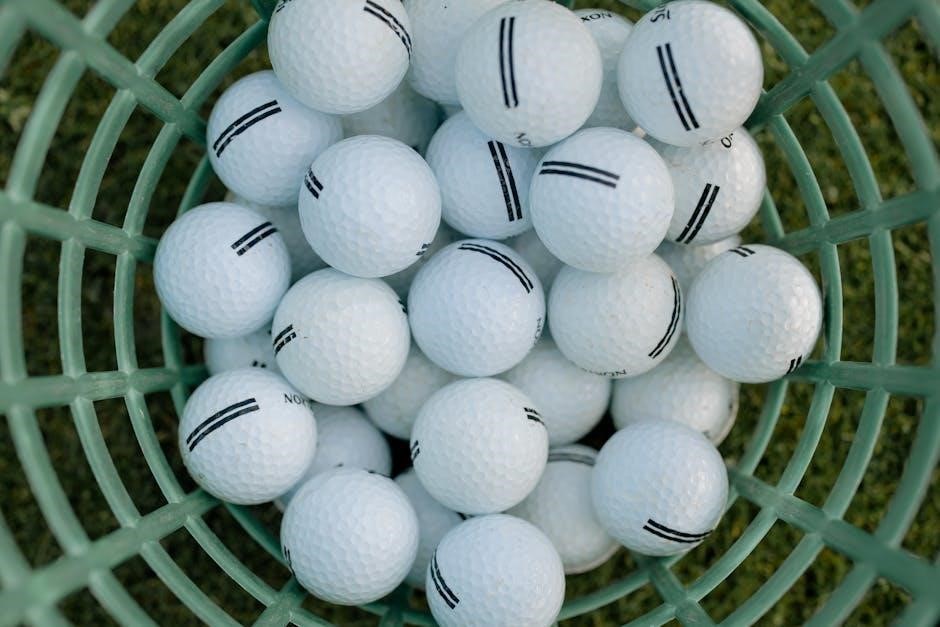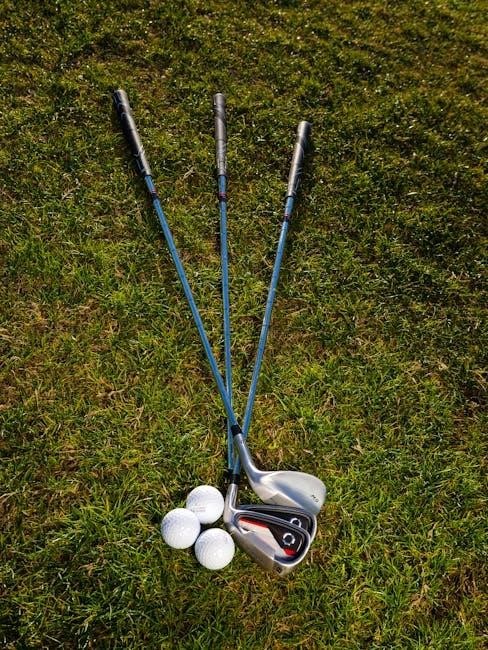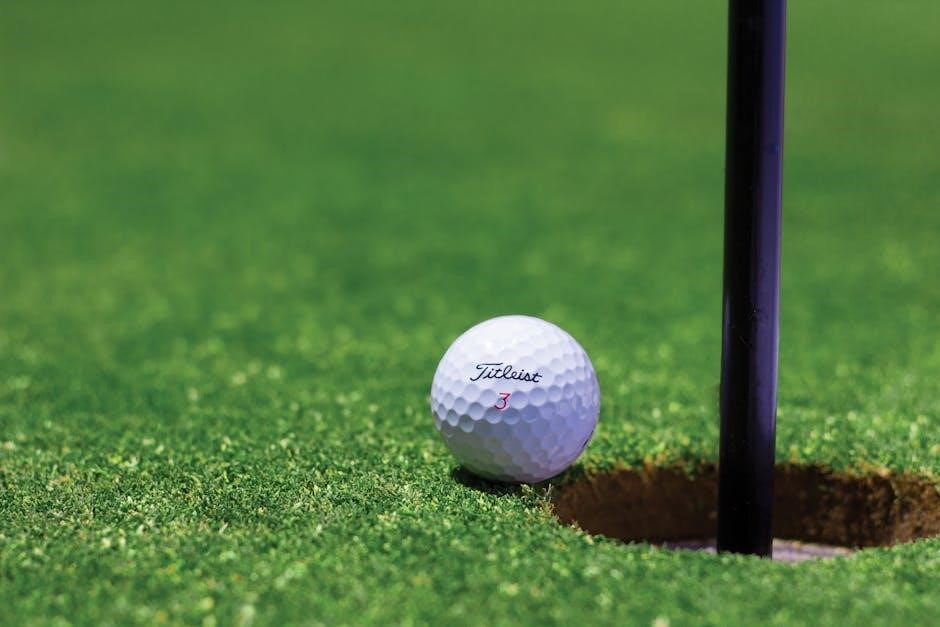Golf shaft flex describes how a shaft bends during a swing, categorized into Extra Stiff, Stiff, Regular, Senior, and Ladies. Swing speed determines the optimal flex for performance and accuracy.
What is Golf Shaft Flex?
Golf shaft flex refers to the degree of bending a shaft undergoes during a swing. It is categorized into Extra Stiff (X), Stiff (S), Regular (R), Senior (A), and Ladies (L) flex. These categories help match the shaft’s flexibility to a golfer’s swing speed and style, ensuring optimal performance. A stiffer shaft suits faster swings, while more flexible shafts are better for slower tempos. Proper flex ensures consistent ball striking and improved accuracy, making it a critical factor in club fitting and overall game improvement. Understanding and selecting the right flex is essential for maximizing distance and control.
Importance of Shaft Flex in Golf Performance
Shaft flex is a crucial element in optimizing golf performance. It directly impacts ball flight, accuracy, and distance. A shaft that is too stiff or too flexible for a golfer’s swing can lead to inconsistent shots, such as slices or hooks. Proper flex ensures the clubhead returns to square at impact, delivering a more consistent strike. It also influences feel and control, as a well-matched shaft aligns with the golfer’s swing speed and tempo. Choosing the right flex enhances overall performance, making it a vital component of club fitting and improvement.

Understanding Shaft Flex Categories
Golf shafts are categorized into Extra Stiff, Stiff, Regular, Senior, and Ladies flex options, each designed to suit different swing speeds and player preferences for optimal performance.
Common Shaft Flex Types: Extra Stiff, Stiff, Regular, Senior, and Ladies
Golf shaft flex is categorized into five primary types: Extra Stiff, Stiff, Regular, Senior, and Ladies. Each flex type is designed to match specific swing speeds and player needs. Extra Stiff shafts are ideal for golfers with very fast swing speeds, typically above 110 mph, offering maximum stability. Stiff shafts suit players with swing speeds between 95-110 mph, providing a balance of control and power. Regular flex is best for average swing speeds (75-95 mph), while Senior (suitable for 65-85 mph) and Ladies (for slower swings, under 65 mph) offer more flexibility for smoother tempos. Choosing the right flex ensures optimal performance, distance, and accuracy.
How Shaft Flex Affects Ball Flight and Accuracy
Golf shaft flex significantly influences ball flight and accuracy. A shaft that is too stiff for a player’s swing speed may not flex enough, leading to a less efficient energy transfer and misalignment of the clubhead at impact, resulting in reduced accuracy. Conversely, a shaft that is too flexible can cause excessive droop or twist, also affecting accuracy. Proper shaft flex ensures the clubhead is square at impact, promoting better control and direction. It also impacts trajectory, as optimal flex can achieve a more favorable launch angle, enhancing both distance and precision. Additionally, shaft flex can influence spin rates and side spin, further affecting accuracy. Thus, matching the right shaft flex to a golfer’s swing dynamics is crucial for consistent and accurate ball flight.

Swing Speed and Shaft Flex Relationship
Swing speed directly influences shaft flex selection. Golfers with higher swing speeds require stiffer shafts for better control and consistency, while slower swings benefit from more flexible shafts to optimize performance.
How to Measure Swing Speed for Shaft Flex Selection

Measuring swing speed is crucial for determining the ideal shaft flex. Golfers can use launch monitors, radar devices like Doppler, or smartphone apps designed for swing analysis. These tools provide accurate readings of swing speed in miles per hour (mph). Many golf professionals and club fitters also offer swing speed assessments using advanced equipment. Once measured, this data helps identify the appropriate shaft flex to match your swing dynamics, ensuring optimal performance and accuracy on the course. Accurate measurements are essential for a proper shaft flex fitting.
Shaft Flex Recommendations Based on Swing Speed Ranges
Swing speed is a key factor in selecting the right shaft flex. Golfers with slower speeds (under 75 mph) benefit from Ladies or Senior flex shafts, which are more flexible. Those with moderate speeds (75-95 mph) should opt for Regular flex, while faster swings (95-110 mph) require Stiff flex. For extremely fast swings (over 110 mph), Extra Stiff shafts are recommended. Proper alignment of shaft flex with swing speed ensures better control, accuracy, and distance. Incorrect flex can lead to inconsistent ball flight and reduced performance.
Adjusting Shaft Flex for Different Club Types (Driver, Irons, Fairway Woods)

Shaft flex varies across club types to optimize performance. Drivers typically require stiffer shafts (Extra Stiff or Stiff) for faster swing speeds, improving ball flight accuracy and distance. Irons often use lighter, more flexible shafts (Regular or Senior), enhancing feel and control. Fairway woods benefit from slightly stiffer shafts than irons but softer than drivers to balance distance and forgiveness. Proper shaft flex alignment per club type ensures consistent performance, while mismatched flex can lead to inconsistent shots and reduced overall game effectiveness.

Shaft Flex Charts and Guides
Shaft flex charts provide guidelines for selecting the right flex based on swing speed, offering tailored recommendations for drivers, irons, and fairway woods to enhance performance and accuracy;
Using a Shaft Flex Chart to Determine the Right Flex
Shaft flex charts are tools designed to match your swing speed with the appropriate shaft flex, ensuring optimal club performance. These charts categorize swing speeds into ranges, such as under 75 mph for Ladies or Senior flex, and 110 mph or above for Extra Stiff. By aligning your swing speed with the chart’s recommendations, golfers can identify the ideal flex for their clubs, enhancing accuracy and distance. This method provides a clear and structured approach to selecting the best shaft flex for improved gameplay.
Examples of Popular Shaft Flex Charts (e.g., Project X, KBS)
Project X and KBS offer detailed shaft flex charts tailored to various swing speeds and player needs. Project X uses a numerical system, with options like 5.0 (Regular) to 7.0 (XX-Stiff), catering to precise swing dynamics. KBS charts focus on optimizing performance for specific swing speeds, such as their MAX HL shaft designed for average swingers. These charts provide clear guidelines, helping golfers match their swing speed to the ideal flex, ensuring better accuracy and distance. They are widely trusted tools for selecting the right shaft flex, enhancing overall gameplay.

Additional Factors Influencing Shaft Flex Choice
Shaft weight and torque also play crucial roles. Lighter shafts increase swing speed but may lack stability, while heavier options provide control. Torque affects clubface alignment at impact.
Shaft Weight and Its Impact on Swing Speed and Flex
Shaft weight significantly influences swing speed and flex performance. Lighter shafts (50-60g) increase swing speed but may feel less stable, while heavier shafts (70g+) offer more control but can slow swings. For drivers, under 85 mph swing speeds benefit from lighter shafts, 85-95 mph suits mid-weight (60-70g), and over 95 mph requires heavier shafts for stability. Balancing weight and flex ensures optimal performance, as improper pairing can reduce accuracy and distance. Weight preferences vary, so matching shaft weight to swing dynamics is crucial for consistent play.
Shaft Torque and Its Role in Flex Selection
Shaft torque measures a shaft’s twist during a swing, typically in degrees. Lower torque reduces clubhead twist, enhancing accuracy for stronger players, while higher torque suits slower swings for better feel. Balancing torque with flex and weight ensures optimal performance, as mismatched torque can lead to inconsistent shots. Proper torque aligns with swing tempo, improving ball flight and overall consistency.

Choosing the Right Shaft Flex for Your Game
Selecting the ideal shaft flex involves assessing your swing speed, tempo, and style. Proper flex enhances performance, accuracy, and consistency, optimizing your overall golf experience.
Self-Assessment for Determining Your Ideal Shaft Flex
A self-assessment involves evaluating your swing speed, ball flight, and comfort level. Start by measuring your swing speed with a radar device or at a golf store; If your balls consistently slice or hook, it may indicate a shaft flex issue. Consider how the club feels during your swing; a stiff shaft might feel boardy if you have a slower swing speed, while a flexible shaft might feel too whippy. Additionally, note your 7-iron distance and launch angle to further refine your assessment.
When to Consult a Professional Club Fitter

If you’re unsure about your ideal shaft flex or experience inconsistent ball flight, consulting a professional club fitter is highly recommended. They use advanced tools like launch monitors and swing analyzers to measure your swing speed, tempo, and ball impact. A fitter can identify if your current shaft is too stiff or flexible and recommend the best options for your swing characteristics. This is especially valuable for golfers transitioning between categories, such as from Regular to Stiff, or those seeking a customized shaft flex for specific clubs like drivers or irons. Their expertise ensures a precise fit, enhancing your performance and confidence on the course.